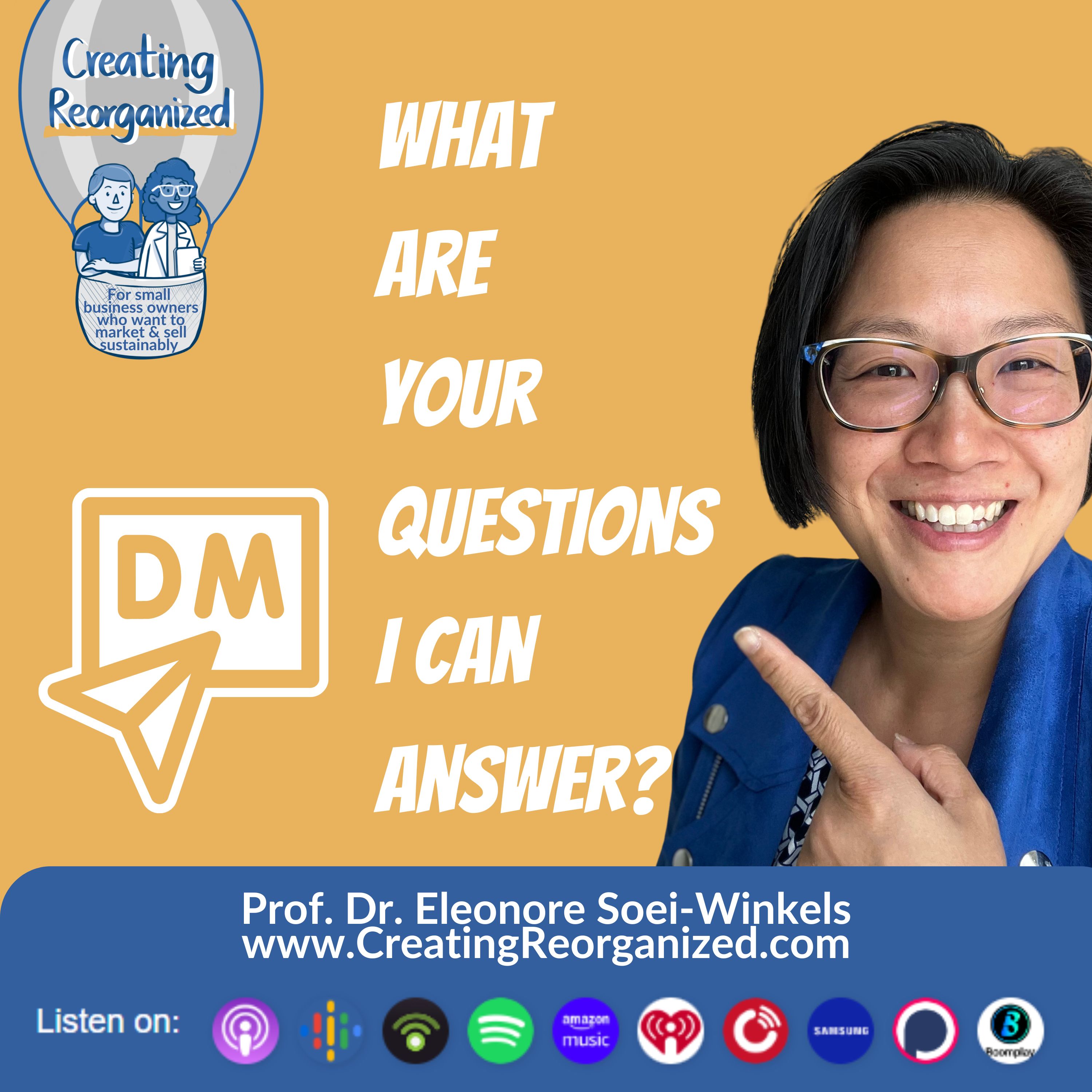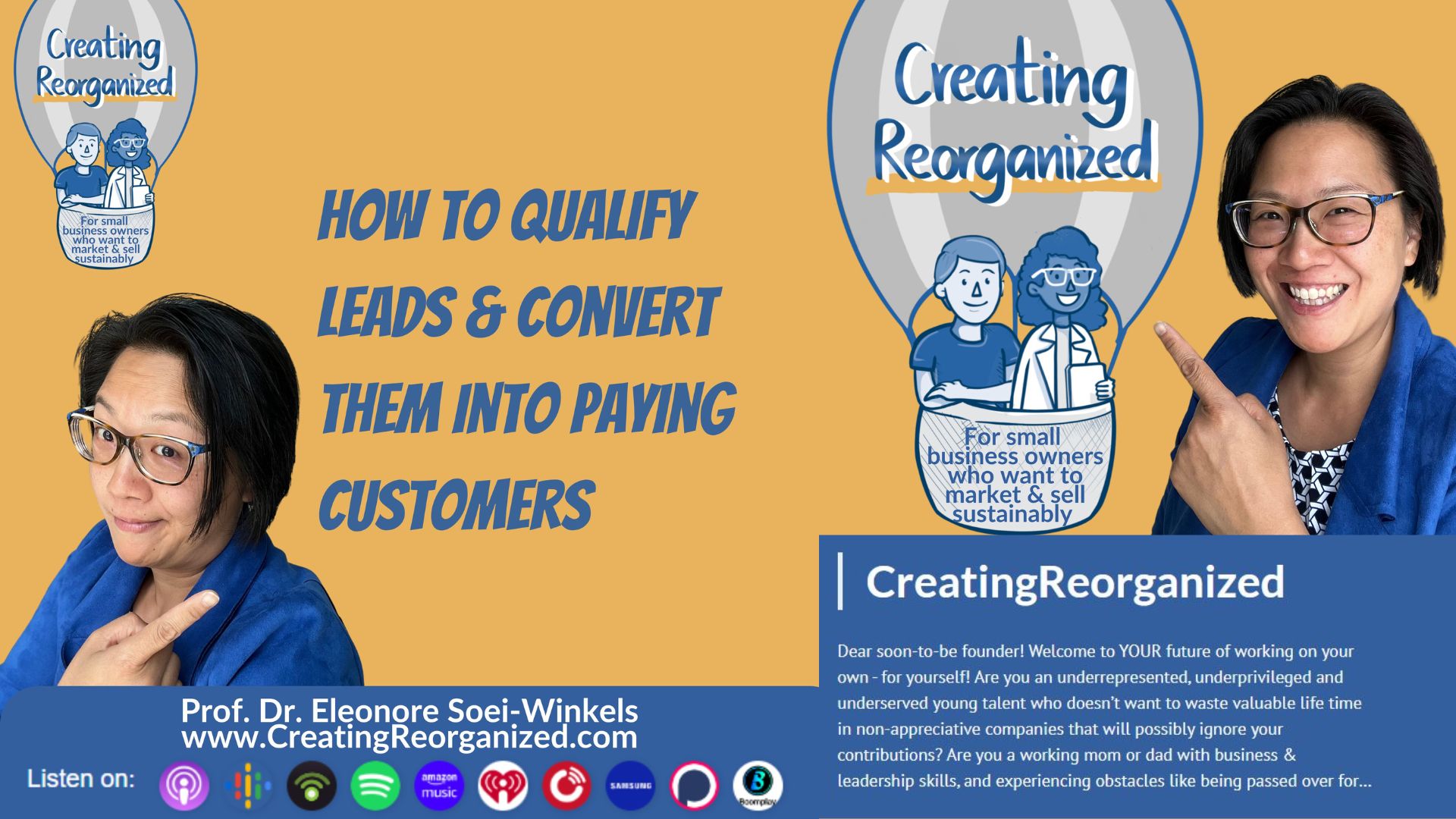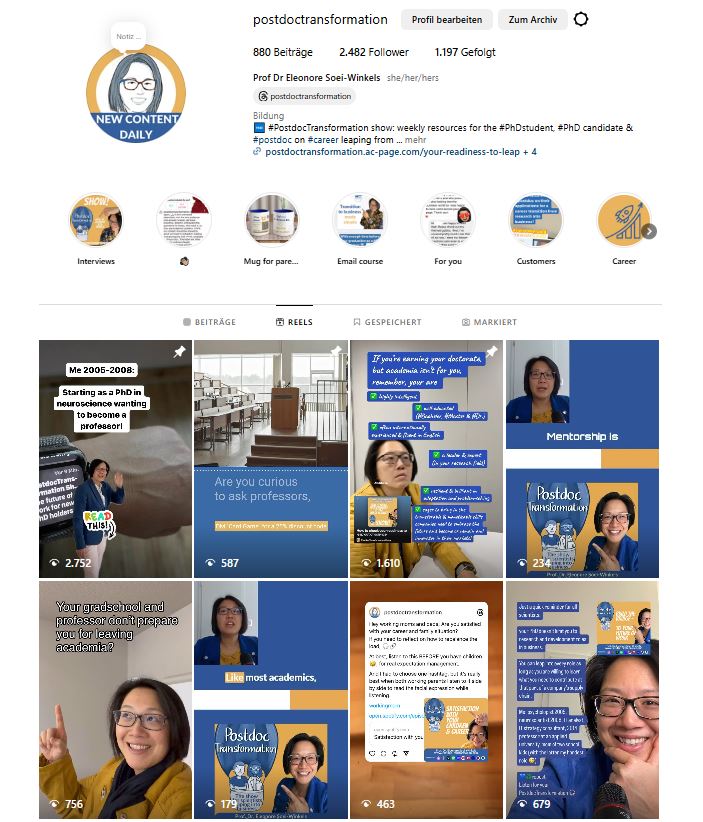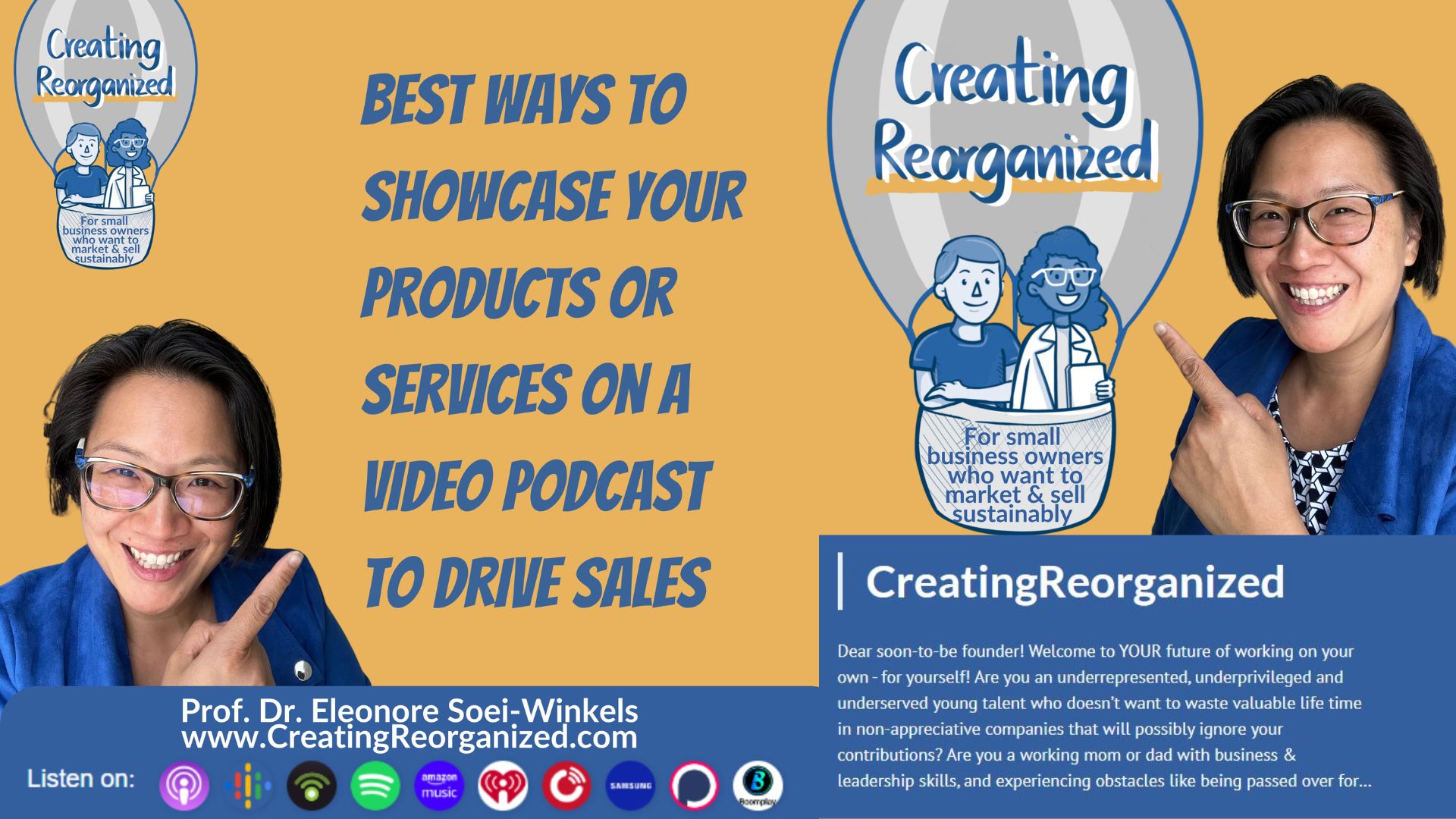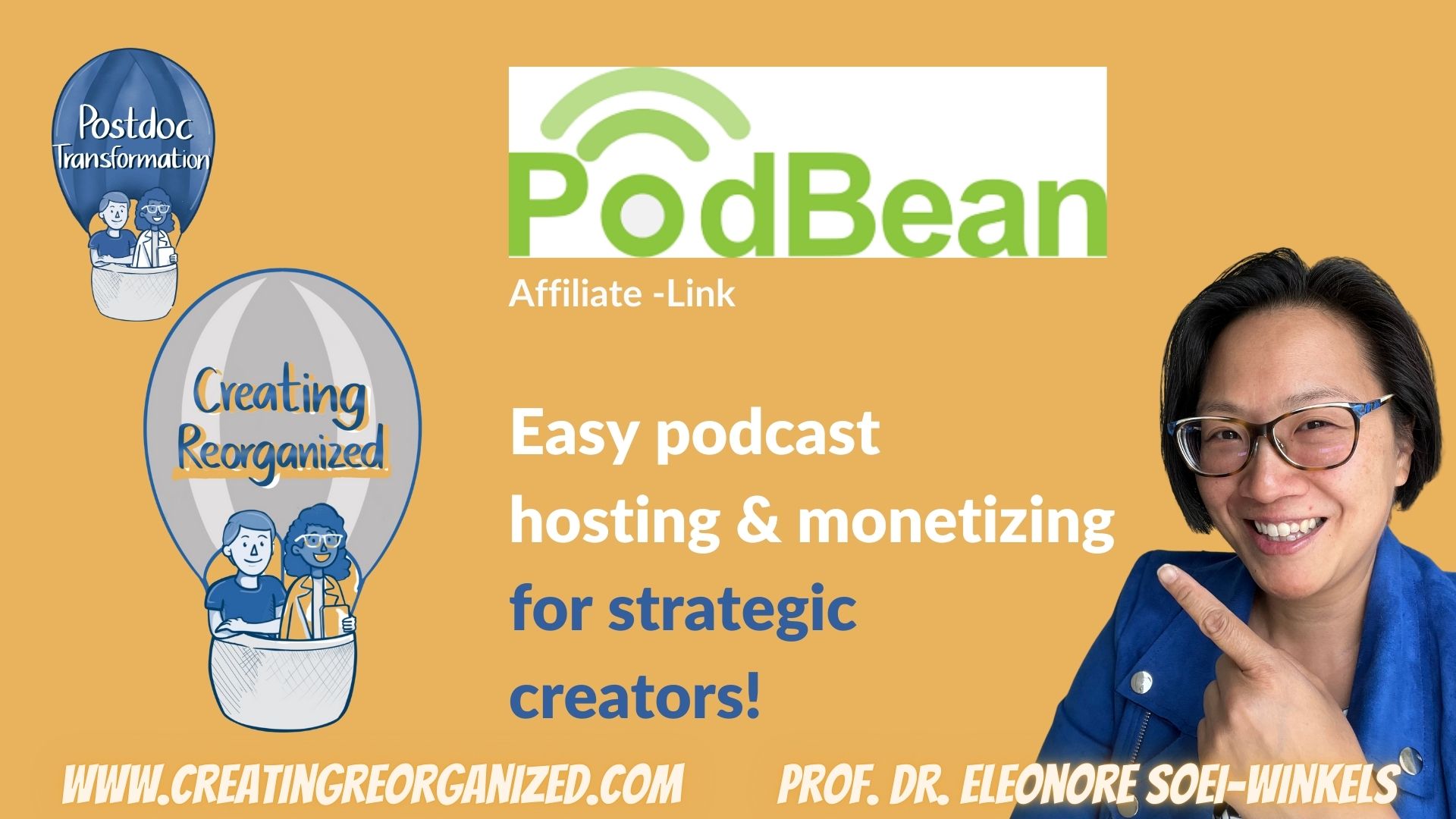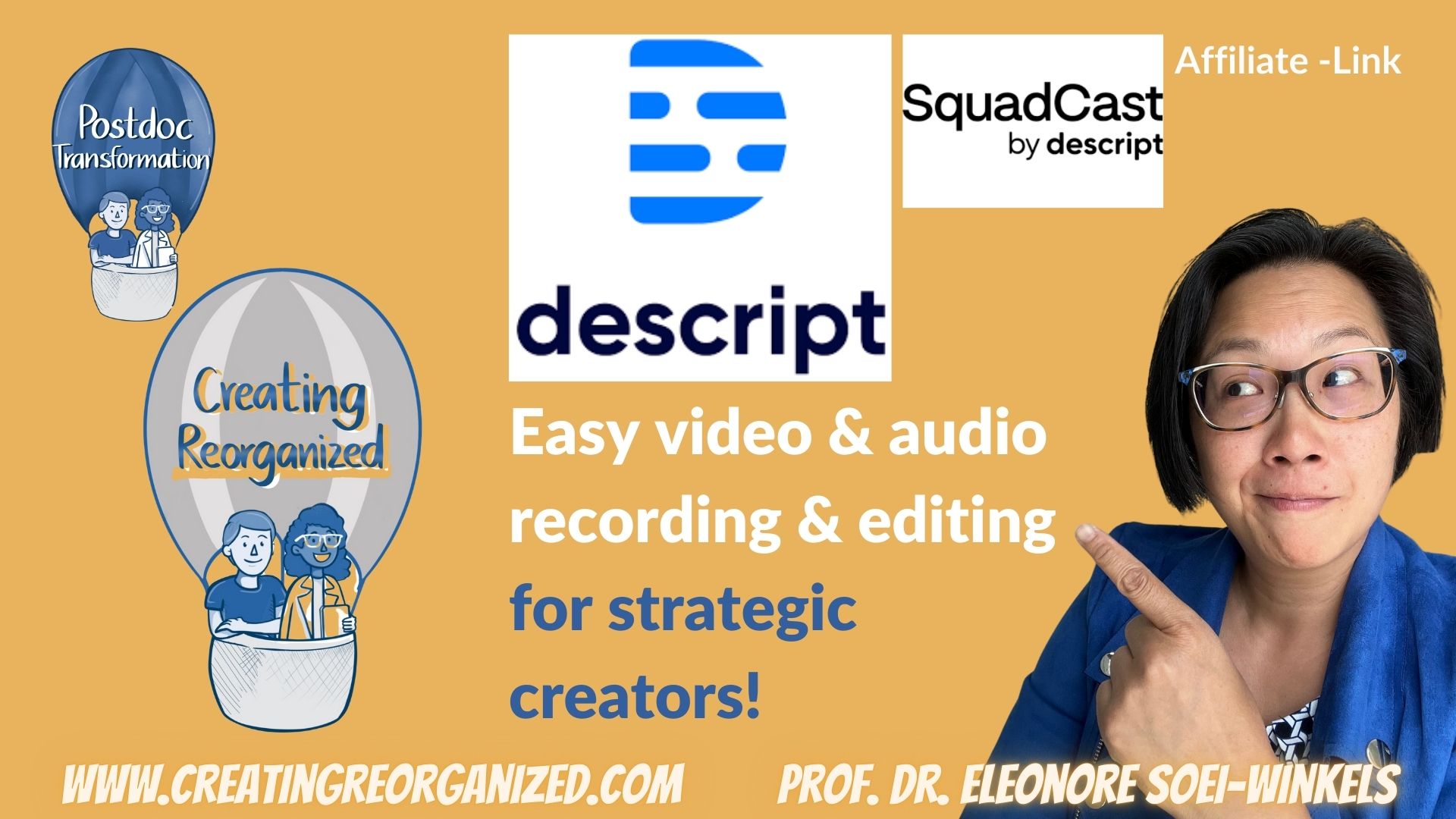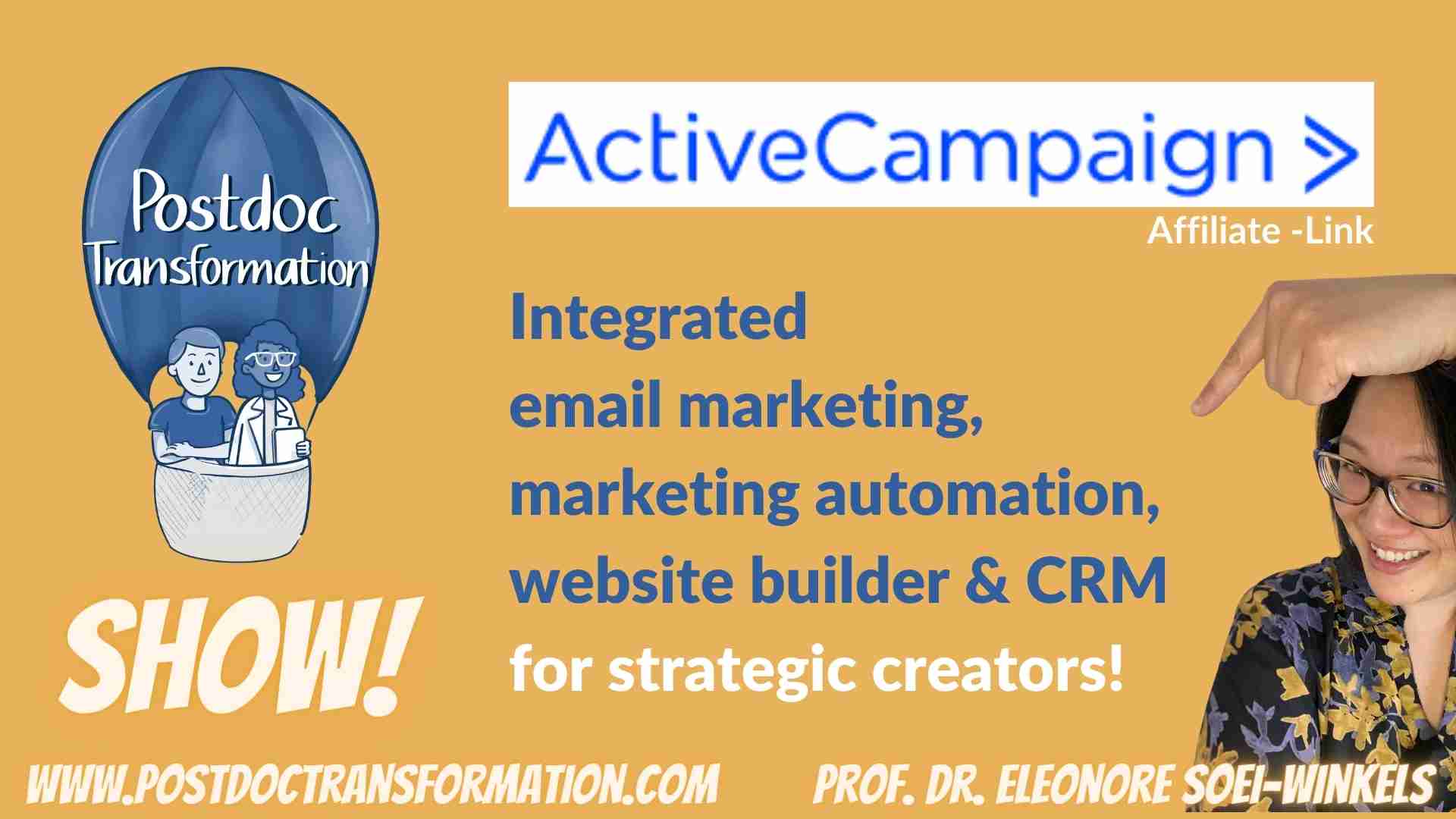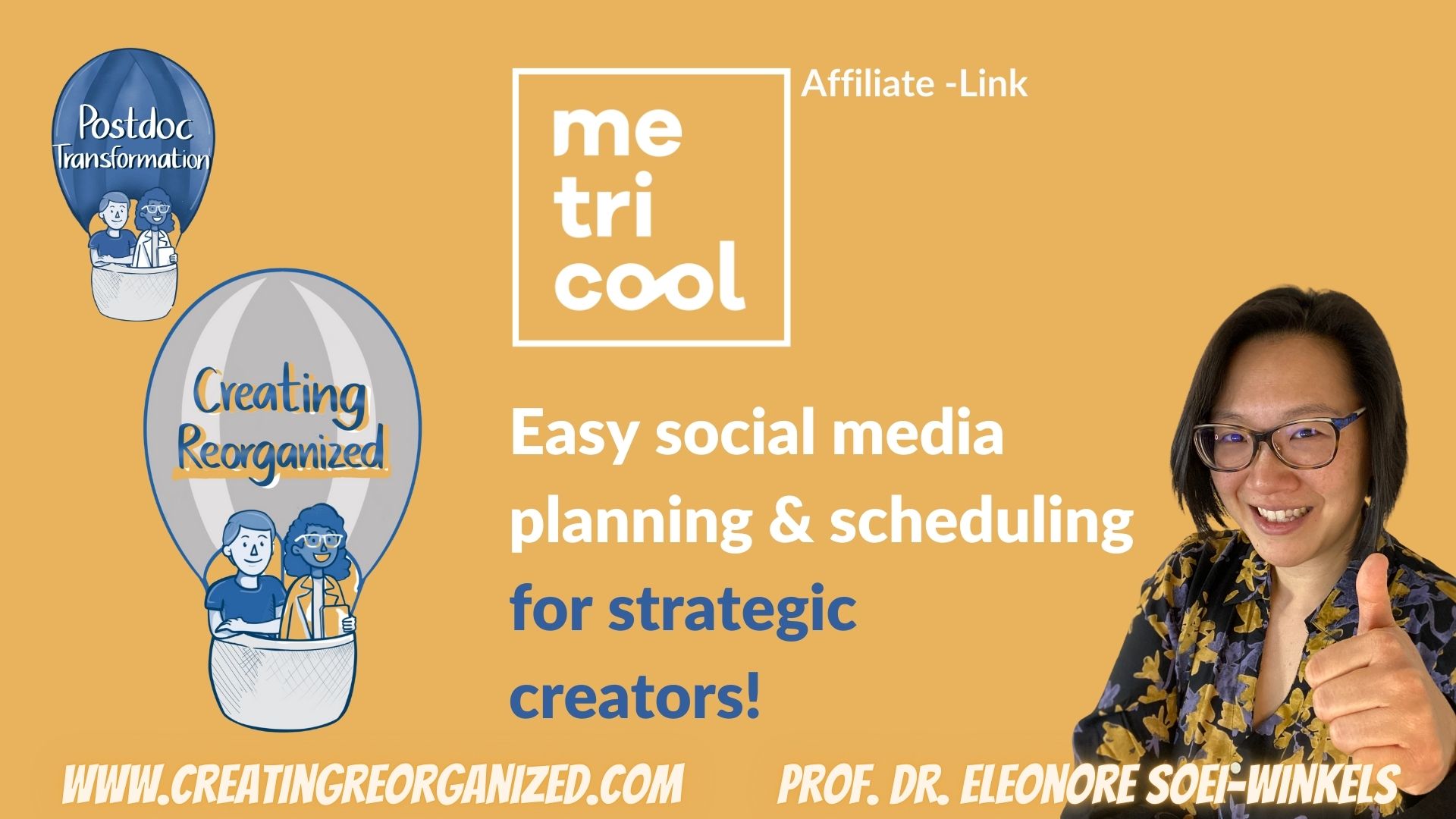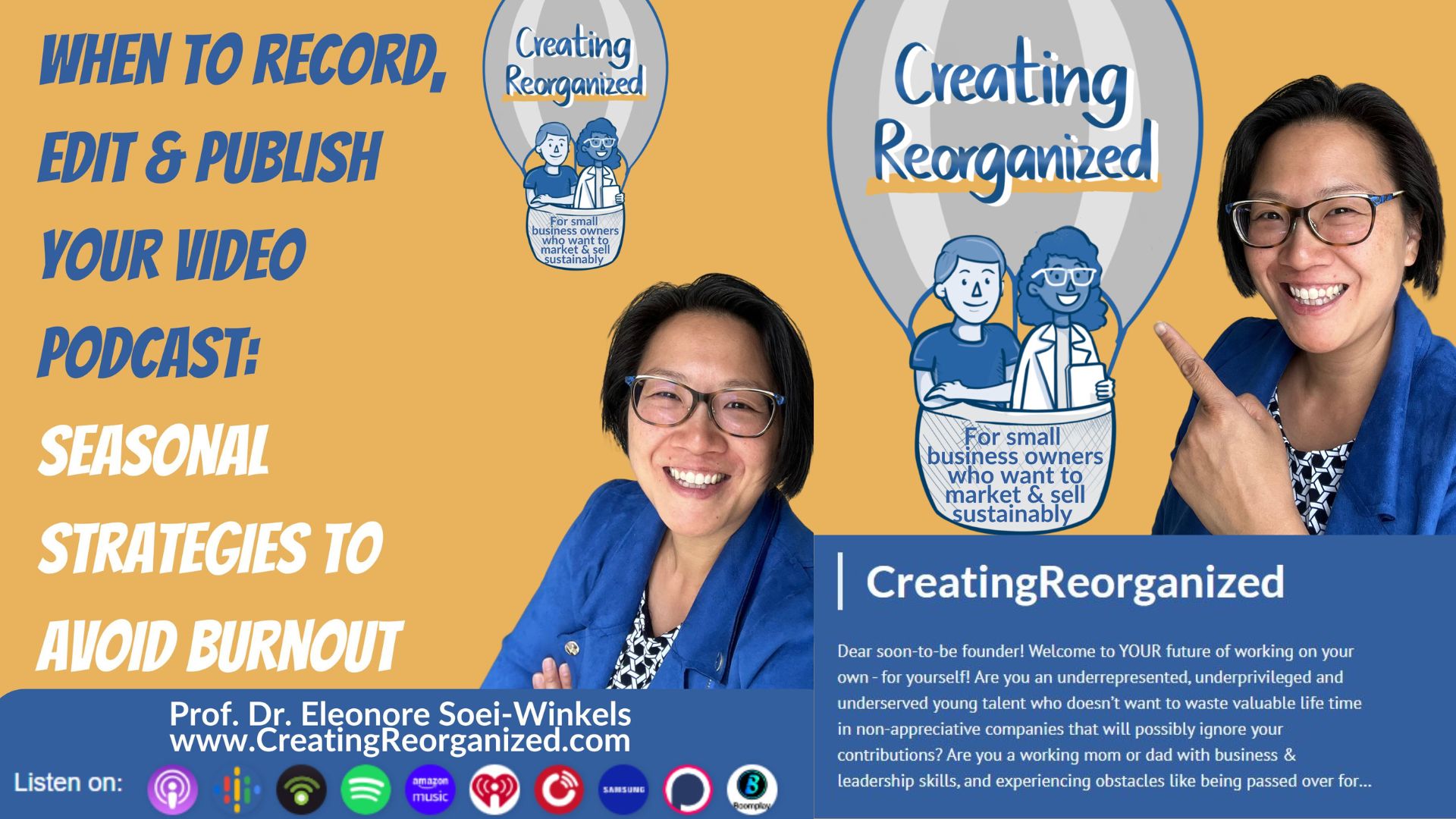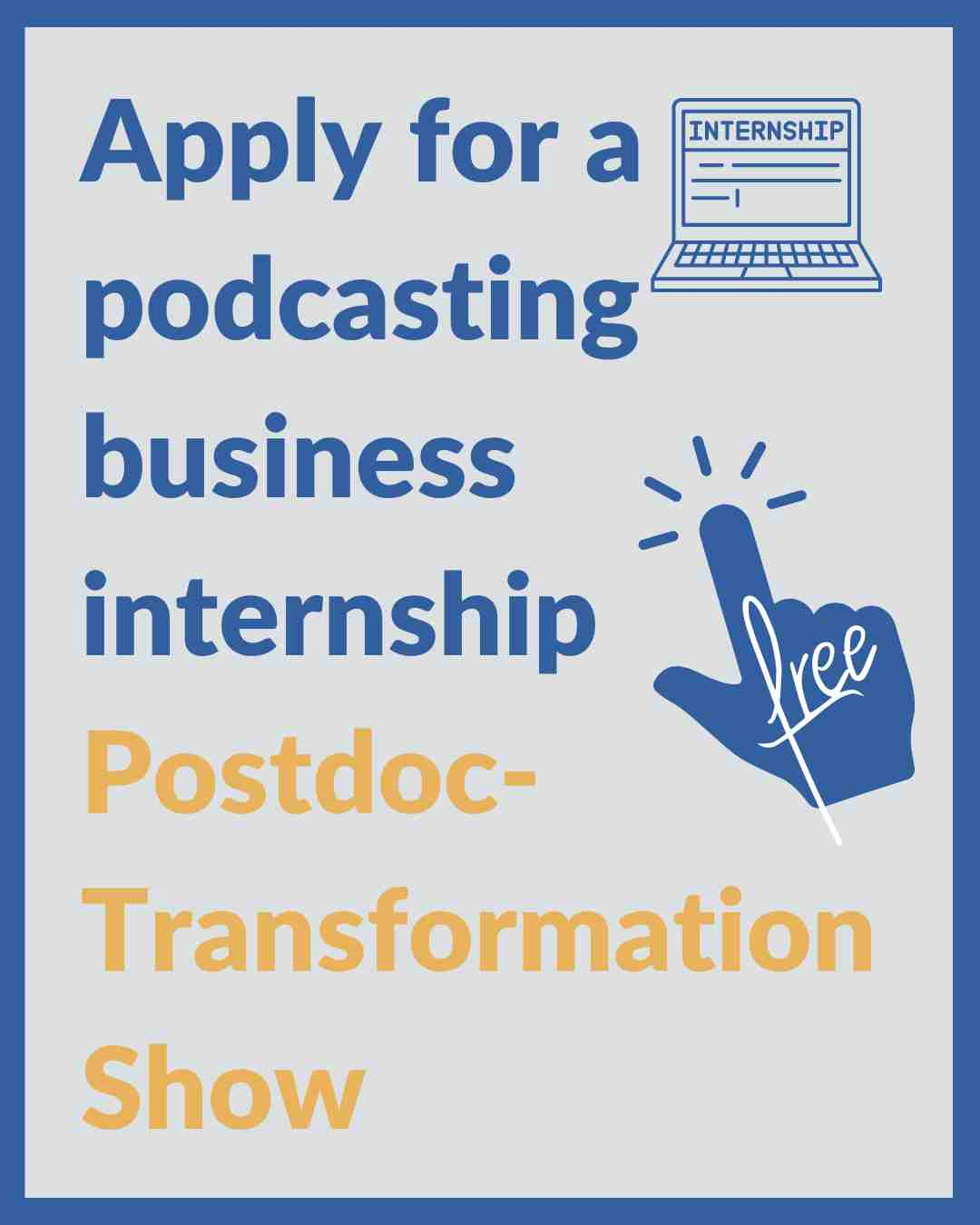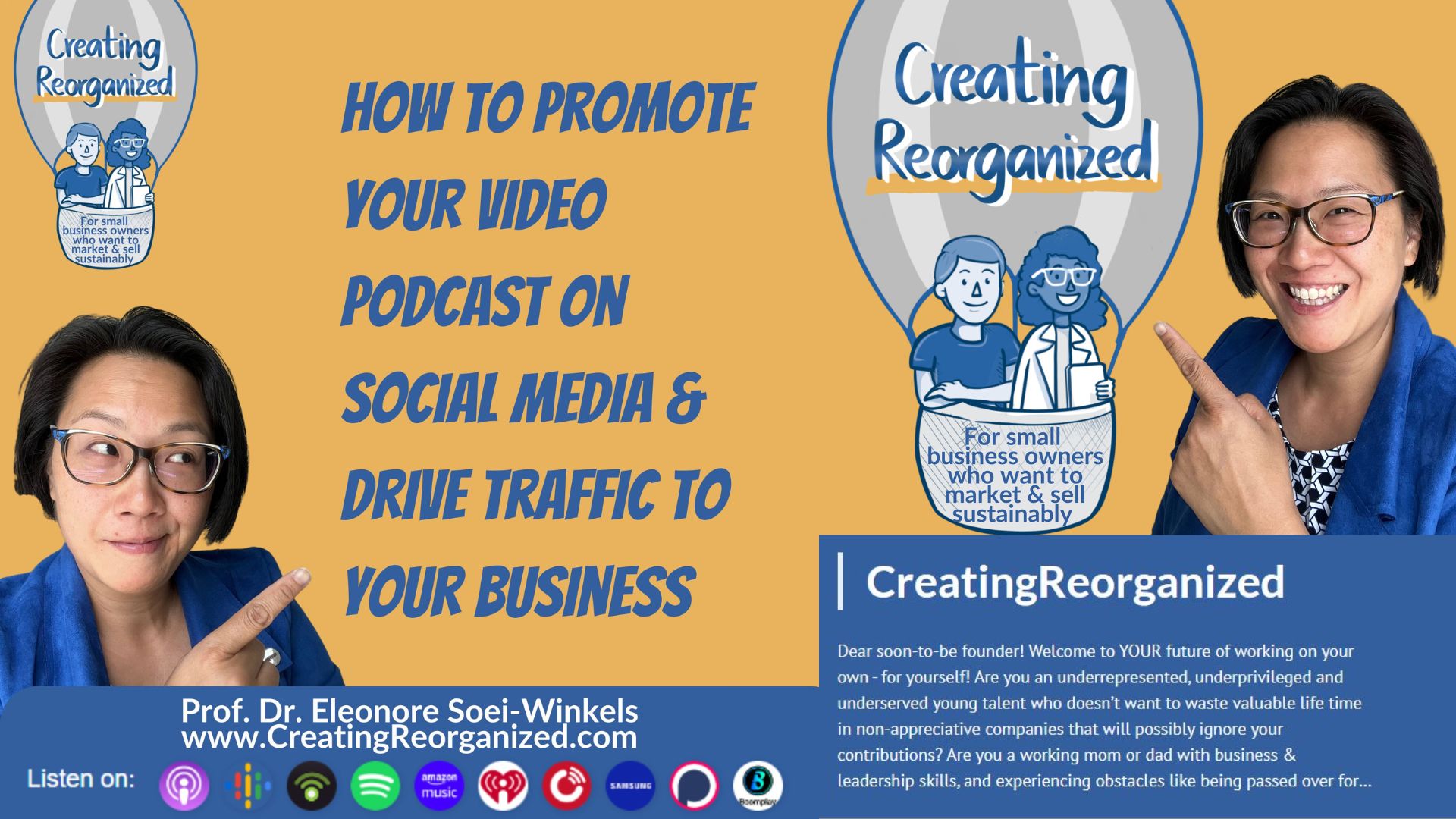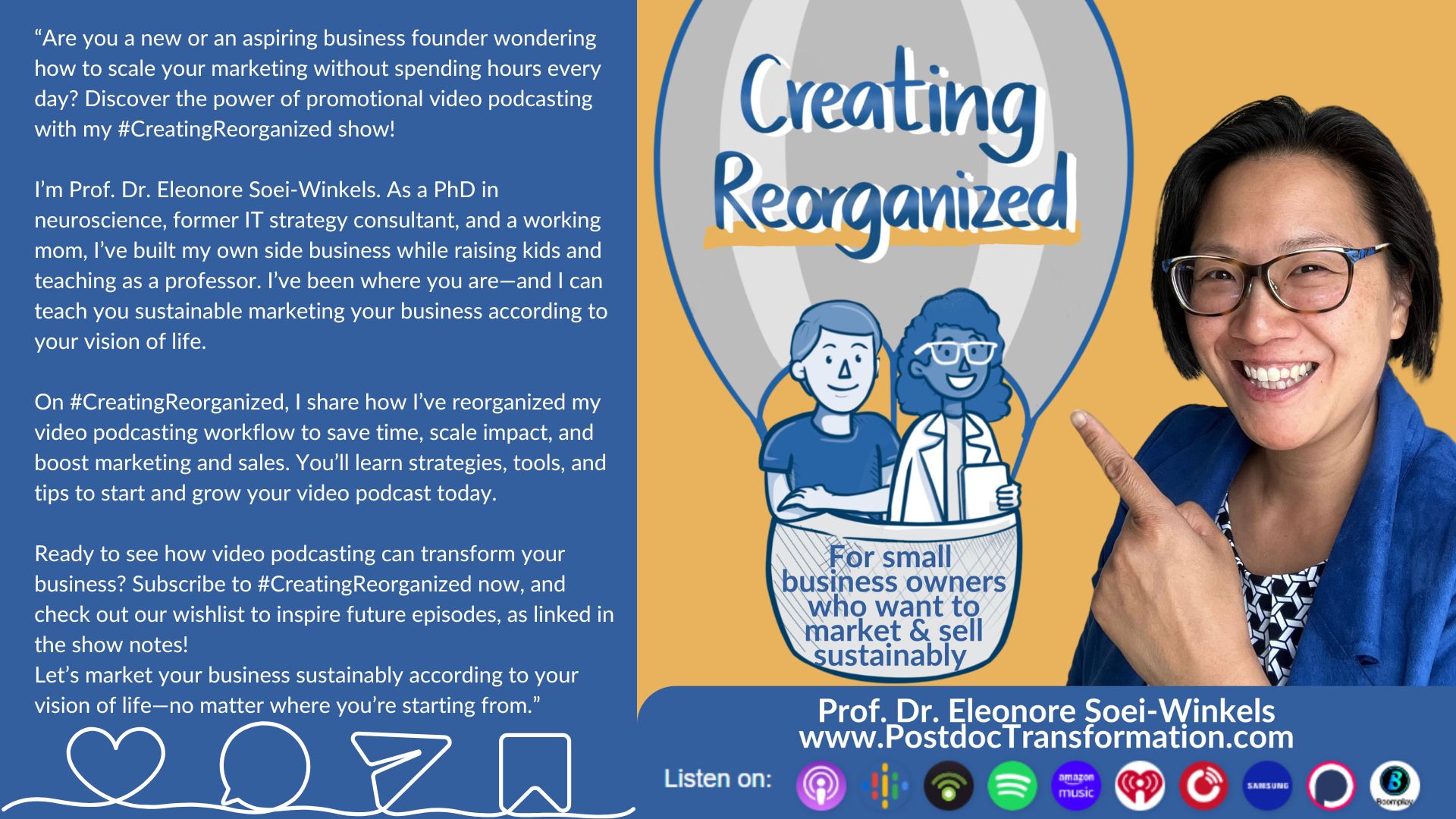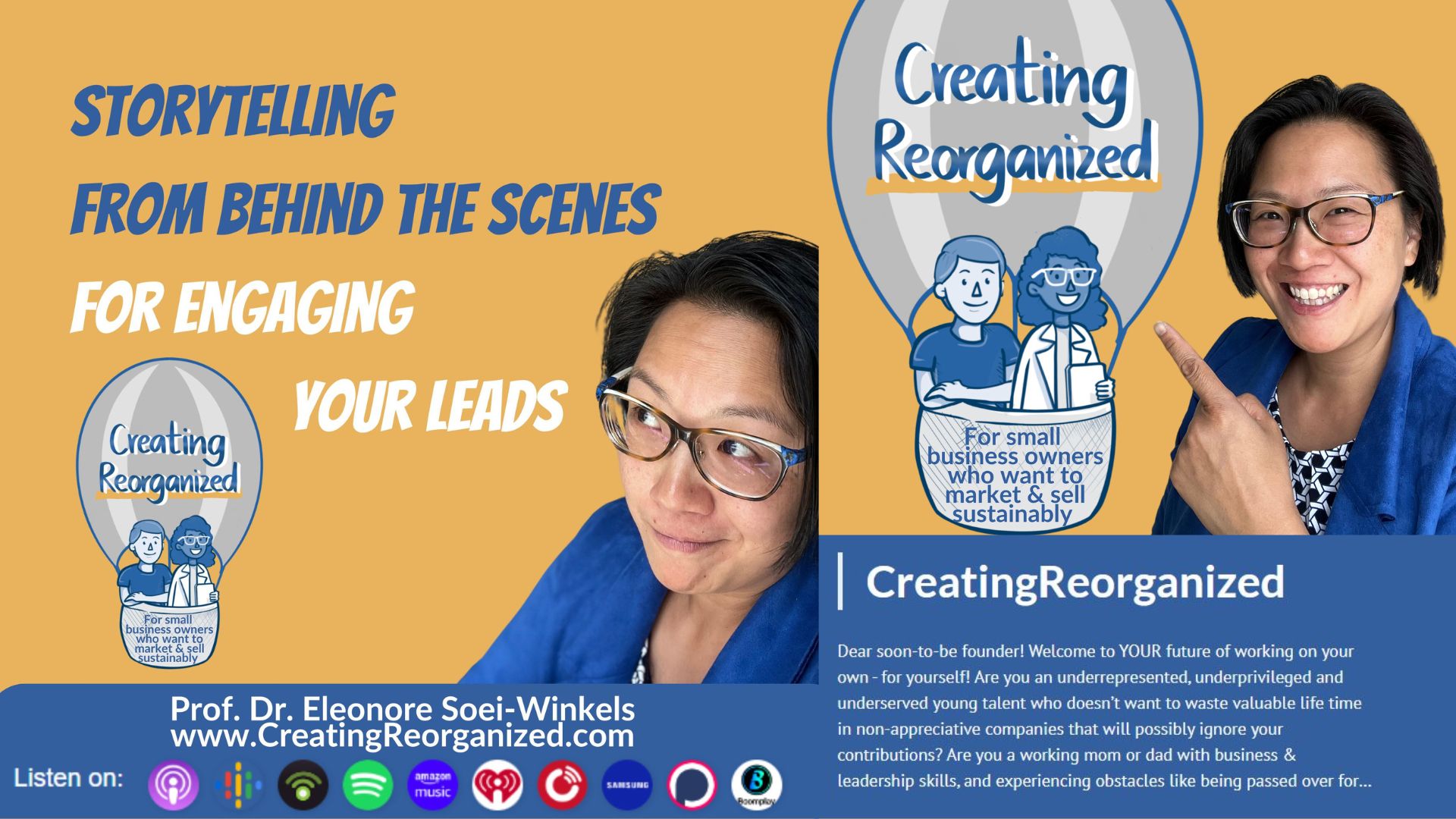
Storytelling from behind the scenes for engaging your leads, CreatingReorganized show
In this episode of the #CreatingReorganized show, you’ll uncover the art of storytelling to engage and convert your leads. Prof. Dr. Eleonore Soei-Winkels delves into the transformative power of behind-the-scenes stories for small business owners and content creators. The episode highlights the significance of authenticity, transparency, and relatable storytelling to build trust and boost sales.
Your will learn how you can use Bandura's Social Learning Theory for your storytelling that resonate with your audience.
By the end of the episode, you'll be equipped with actionable strategies, like a Meet-Your-Clients series (case study: #PodbeanAmplified by @Podbean) to turn your daily business experiences into engaging content that attracts, engages, and converts leads into loyal customers. Don't miss this guide to using storytelling as a strategic tool for your business video podcasting.
If you are a new or aspiring founder of your small business and have no time to waste, or really struggle to do your social media marketing, you will enjoy our #CreatingReorganized show!
In my day job as a psychology professor I teach my bachelor and master students in real life, how to reorganize processes in a goal-directed and future-proof way in companies. That’s what I had done for a living as a former IT strategy consultant.
For my own career coaching business on the side, I can only dedicate a fraction of my time – because I prioritize care work for my little children. I face the same or similar challenges like all small business owners. So, I applied all my experience and knowledge to create my other video podcast #PostdocTransformation to streamline my social media marketing and to boost sales of my coaching, e-courses and affiliate products or services.
I strategically capitalize on professional tools to scale my impact according to my vision of life.
Listen and subscribe to this #CreatingReorganized show, so you will learn to do the same for your own business, to build the know, like and trust factor and to boost sales of your services or products!
Please also ask your business-specific questions, because for season 2, I envision interview episodes with aspiring and new founders like you, if you want to get your #CreatingReorganized according to your vision of life!
[00:02:15] Dear Creating Reorganizer, welcome to this episode of the CreatingReorganized Show, where we help small business owners like you to use the power of authentic and relatable storytelling in your video podcast to engage your audience and grow your business sustainably.
[00:02:31] Today I wanna share with you one of the most powerful yet underused strategies in marketing, sharing behind the scenes stories. This episode is all about authenticity, transparency, and the value of letting your audience in on the real journey of running your business. We'll discuss:
1) Why authenticity resonates with modern consumers.
2) Marketing principles behind storytelling.
3) Practical ways to craft and share behind the scenes stories that, engage your audience.
4) Actionable steps to start creating your own behind the scenes content.
5) Psychological models, theories, and concepts so that you have a scientific foundation for what you do.
By the end of this episode, you will have the tools to turn the everyday moments of running your business into compelling stories to build trust, loyalty, and sales.
1) Why authenticity resonates with modern consumers.
[00:03:29] So here's part one, why authenticity resonates with a modern consumer. Well, let's start with a big question. Why do vulnerable, inspiring and behind the scenes stories matter?
[00:03:42] I have to say, as a professor teaching psychology since 10 years now, the moments that matter most to my more or less professionally experienced, more or less humanly mature bachelor master and PhD students, or even postdoc scientists, are the stories that I tell to exemplify the theories, models, and concepts of my given curriculum or career transition workshop.
[00:06:06] Essentially what I try to do here in the video podcast is the same that I have always been doing in the classroom. The more I am able to present the, to be learned knowledge to them as individuals with a unique background, the better they are able to anchor that in their own experience and to relate that and to work with that mentally, to own that experience, to own that knowledge. How do I do that? When students come to me before or after our lectures or during the breaks, they ask and share about their real anxieties. That's when I know that I have taught them something that hit home and they are vulnerable, sharing with me something that I can then use to make it easier for them to capitalize on the knowledge that I wanna present to them in the future.
[00:07:00] So I try to memorize everything that they tell me, so that I can mention that then in the lecture saying someone asked me from another lecture because of that background, maybe that is also relatable to you, so let me share that story. Obviously I don't say any names, but the stories are real and they're probably also relatable to them.
[00:07:23] So don't you want this also in your marketing and selling, these are the moments when your leads realize their pain points, have the feeling that you understand them and that you have the solution they need to heal from their pain and to even thrive as your service or product helps them to overcome their challenges, to become their aspirational identity.
[00:07:47] You are pitching the vision of their desired transformation, and that really is so powerful through storytelling because you listen to your clients, you listen to your leads, like I listen to my students. So let's do some reverse engineering, shall we? reverse engineering means that this is what you want, and then you go back and think of the steps that are needed to reach the top, right?
[00:08:15] Understanding Your Audience
[00:08:15] So how well do you really know your video podcast audience? Remember in the second episode that I asked you to speak to your existing clients about their pain points. That episode is called How to Qualify Leads and Convert Them Into Paying Customers, as linked in the show notes.
[00:08:33] In short, chances are quite high that your existing client's pain points are relatable to your video podcast audience. So that's a good starting point to craft your stories. You can engage via polls and social media by asking them to share their point of view. It's important to ask your audience when you meet them, what they bring to the table and what they wanna achieve for their future. So in order to understand and capitalize the most on what you say, your audience needs to anchor and relate that to their own unique experience. And while it's their task to anchor and relate. You cannot control that.
[00:09:15] I mean, when they're sleeping, they're asleep, right? They're not listening, but they have already shown that they're interested because they have clicked to listen. If you bring value to them, they will also listen until the end of this episode. But the thing is, they can only make the most out of that episode if they can relate that to themselves.
[00:09:37] And you cannot control for what they do with that knowledge. But when you're asking them about the background and the pain points, and they let you know, that will help you craft stories that resonate with them.
Learning about your audience's pain points to serve them better with relatable stories
[00:11:59] So if learning about your audience's pain points to serve them better with relatable stories is your goal, here's a trick if you are authentic, sharing your own obstacles and how you overcame them, as needed and useful in the given context. You create a space in which they feel safe to share about the real anxieties when you share and be a role model about sharing your own mistakes, they are allowed to make mistakes, and that's where you can decide whether your service or product is the best solution for them or not. In the long run, you gain more if you understand that your business is not the best for them and recommend maybe even a competitor so that everyone wins. A happy customer is growing with you.
[00:12:49] But if you are not the best fit for them, they will be unhappy and it will take more time for you to adjust your services to serve them well. With the preparation of storytelling and the resulting evaluation of the fit between your potential clients and your business, you can then identify your ideal clients.
[00:13:11] Let me be clear. It's easier to satisfy your ideal client than to make a suboptimal client happy with your business, right? You can work in your zone of genius, vibing with your clients, and you and your client are both growing. And at the end of the day, you are building trust and showing that you aren't desperate to make every deal, but to only make a deal when it makes most sense for your client and you, in that order. So that customer centric and attentive, considerate approach is the opposite of being salesly.
[00:13:49] Humans need to trust you before buying from you, right? And that really is impossible through glossy, perfected advertisement. It's built through relatable human stories. And that's why big corporate companies with multiple brands work with influencers who step in as the human face and voice to build the know, like, and trust factor.
[00:14:11] And believe me, the big corporate brands probably do not really enjoy working with influencers. But they know that it's the only way to build a brand, to have a human brand attached to that.
[00:14:26] They know that big brands aren't relatable. It's the people who are relating to the people. So key reasons why authenticity works it builds trust. Transparency shows that you have nothing to hide and it humanizes your brand.
[00:14:43] So the behind the scenes content reminds people that there is a real person behind the product or service. And that actually also differentiates your business. Stories can make your brand memorable in a crowded market.
[00:14:58] And now you might ask, is there substantial peer reviewed research supporting the importance of authenticity in branding and marketing? Yes, studies have demonstrated that brand authenticity positively influences consumer trust, perceived value, and overall brand loyalty. And I can see that as well.
[00:15:19] So I have two podcasts and I have true loyal fans that support both of the shows even though I know that they are my ideal clients for the main podcast, the PostdocTransformation show. But they have come to like me so much that they still also push the like button and also share my content for the CreatingReorganized show.
[00:15:45] I have asked them, because I was really grateful that they're doing that. And then they said, or wrote to me because I want to see you winning. And that is unbelievable for me, I don't even have words for that because that is more than I could have asked for in creating a brand for myself.
[00:16:05] I deliberately try to have a brand PostdocTransformation where my name is not associated to that, but it's a bigger thing than me. The same with CreatingReorganized. It's bigger than me, but people follow people.
[00:17:53] Studies in marketing have shown that authenticity in branding and marketing is essential for building trust, enhancing perceived value, and fostering consumer loyalty.
[00:18:04] And if you wanna know how you can build and share your brand authenticity and scripting your first season and episodes of your Business Promotional video podcast, I got you covered. The second email of my Creating Reorganized Inner Circle email list has a detailed season and episode storyline that you can customize as needed.
[00:18:24] You can subscribe to our free creating reorganized inner circle email list via the link in the show notes. Let's talk about what you can do. Here's your actionable prompt. Write down three things about your business that feel personal and vulnerable. It does not have to be private, there is a space for being private, which is not your video podcast, which is not your social media, but you can show personal stories and also obstacles that you have overcome.
[00:18:56] Be vulnerable about your mistakes. Choose one of them to share in your next video podcast episode, or even just social media posts to test the water if your audience would like that.
Narrative transportation theory by Green and Brock 2000
[00:19:08] Part two. So let's talk about the narrative transportation theory by Green and Brock 2000. This theory explains why people become immersed in the story, emotionally connecting with its characters, and also the message.
[00:19:25] When you tell your story, your audience will feel connected by it, and they're more likely to remember it. And by extension, also your brand, because you were the one telling them that story.
[00:19:37] The key elements of a compelling story are relatable characters.
[00:19:42] Because you are promoting your business, you, your employees, or even your customers, could be the role model, the aspirational identity of those who already fulfill that.
[00:19:55] So then the next element is a conflict or a challenge. You can share struggles or behind the scenes obstacles. But you have to share them from a perspective that you have already overcome them. So it's not in the moment.
[00:20:12] And then the next element, of course, is the resolution. So show how you overcame the challenge or the lesson that you have learned. And this is why you have to talk about something that you have already overcome, right? You don't wanna leave them hanging in there.
Here's an example for my PostdocTransformation Show.
[00:20:32] My ideal client avatar is my younger self. So young Eleonore best graduate in high school. Multiple interests, eager to make a scientific impact to the world, to make the world a better place. In the show notes, I'll link to some social clips and you can also see how I repurpose my avatar mantra in every episode of the show and also on social media.
[00:20:55] So I really walk my talk of CreatingReorganized. So in every episode, I try to create inspirational, encouraging, and applicable evergreen content because some of my audience are before starting their PhD program. Some are in the beginning, some are in the middle and some are before or after graduation.
[00:21:16] For postdoc scientists, my PostdocTransformation Show matters most because they usually are the forgotten ones. They don't necessarily get systemic career transition or career guidance, and my show is for free as a video podcast. So I created my PostdocTransformation Show to reach those highly accomplished, but poorly supported people all over the world in a format that fits that amounting life. They're already middle aged, maybe they have kids, have a busy life and they can listen to my show while they are doing low, mentally demanding chores in the lab commuting, doing the household chores, waiting for the kids, walk the dogs or whatever. So just like me actually. I really created something that I would have wanted when I was at that stage of life. That is my purpose. And also, to be honest, my legacy as a professor who cares for the next generation of experts and leaders for all of our children.
[00:22:18] And now back to you. So because my life is currently also packed for different reasons, I heavily rely on my digital strategy skills which I have built during my years in IT and business before I became a professor. And here's my plug to connect with me on LinkedIn.
An example of an origin story
[00:23:47] If you can't believe what I'm saying, just connect with me. You can see in my CV that I have really paid my dues. I have practical IT experience, you can see my exact timeline leaping and progressing from one company to another, or from one role to another.
[00:24:04] In short, if you aren't checking me on LinkedIn, what I bring to the table is a compound effect of the steepest learning curve in my life.
[00:24:12] Business is not rocket science, but for scientists like me who hated the capitalized companies during studies and grad schools, it's a huge emotional, mental turnaround. I know that my PostdocTransformers have this or a similar learning curve still before them. One of the biggest challenges was for me that I had no business acumen. I had no idea about the business buzzword, the concept, it was like all foreign to me.
[00:24:42] To be honest, I thought science is superior, doing good things for the world. While business is evil, but really it's not that simple. As a professor, since 10 years, I can say there is power abuse, toxic leadership, mismanagement, everything that you can see in business. But it's badly paid and we should know better because I guess we would be smart enough.
[00:25:07] But we are also human. And because there is not so much, checks and balance, it is easy to land in a lab where your personal development is not the top priority of the chair.
[00:25:25] And on top of that, getting tenure is harder and less happening for the underprivileged, underrepresented, and underserved. So today I challenge my best bachelor and master's students really, really hard if they, and why they want to earn their PhD. And often my scientific coaches who want to leap into business, they come to me because they say they wanna transition from academia to an academia adjacent role. And I can understand that because I know that's in their vicinity of the comfort zone. It poses less risk, I understand that.
[00:26:01] But the thing is, but it offers also less winning opportunities. So I deliberately share that I leaped from my PhD in neuroscience directly into IT. I was hired as an IT analyst, which is an entry level job. Most of my colleagues were men. All of them were younger and half of them had not studied. And it was a humbling experience for me because I had to learn to navigate in the IT and business world.
Sign up to our CreatingReorganized inner circle newsletter, where you can learn and apply my tactical tricks to your marketing challenges and see how business podcasting can help you strategically to reach your goals
Sign up now via this form (made in ActiveCampaign):
[00:26:31] And I stop here because my origin story is more relevant for my PostdocTransformation Show audience. Let's bring that back to you. This is what you can do when you are talking to your own audience. This is the reason why you as a founder or owner of a small business can learn from me CreatingReorganized. These early years after my leap out of science have shaped my will to find strategies to achieve my business goals with digital tools. CreatingReorganized is the product of all my transferable skills and experiences. And you can learn the shortcuts while you apply what I teach you for your own business promotion video podcast.
[00:27:11] As someone with a lean marketing budget, you have no time to lose. You can capitalize on my CreatingReorganized show fully remote 24 7 365 globally. Trust me, a business promotional video podcast on social media is networking strategically with leads, client, competitors, suppliers on speed, having your supply chain in mind. It's the only reason why I still have a business because during the Corona crisis, my local career coaching business crashed, and now I have found an even better business model altogether.
[00:27:49] And you can do this too. Here's your actionable prompt. Identify a recent challenge that you have faced in your business and draft a short story using the structure. In the beginning, you introduce the problem. In the middle, you explain the struggle or journey, and in the end, you share the solution or result.
[00:29:29] Crafting Compelling Behind-the-Scenes Stories
[00:29:29] Speaker: Let's do part three, crafting behind the scenes stories. Okay, now that we understand the why, let's move on to the how.
[00:29:37] So, how can you turn everyday business moments into engaging behind the scenes stories?
[00:29:42] Number one, you can highlight your process. Your audience is curious about how your products and services are made. You can show them the steps involved from idea to finished product. A vacation business could record a video showing a day in the hotel, but also behind the scenes. How the staff takes its time to prepare the breakfast bar, the rooms, events, and activities outside of the hotel or even the gift shop. Share why your staff is dedicated to the guests making their best holiday moments.
[00:30:13] So it's all about the guests, but you're showing off how the memories will be made.
[00:30:19] For example, I wrote my jingles for my PostdocTransformation Show and also for the CreatingReorganized Show, and I shared a video of how I recorded my jingles in a professional singing studio just before I published the trailer for the CreatingReorganized Show.
[00:30:35] So I wanted the jingle before to be teasing that there is a new show. And then I created the trailer, and I published the trailer, and then I published the first episode of the Creating Reorganized Show. And that strategy paid off because that really is the most listened to episode of the CreatingReorganized Show.
[00:30:57] Most people want to listen to me singing, and then they're curious. So for me, in both of my shows, what you see and what you hear is what you get. Both of my shows are 100% me and I have the same professional attitude, quality standards as in my day jobs. And because I also share my CreatingReorganized show social clips on all my social media platforms, my PostdocTransformation audience also gets to know my strategies and effort behind the scenes. And I think that if they take the time to listen to that, they will even appreciate more the work that I have done for them already for free. And I also want to encourage them to leap into new markets and to invest time and effort into their learning curves.
Share your why
[00:31:43] So number two, share your why. What motivated you to start your business? Sharing your mission of why you wanna do this creates emotional resonance. The more you attract your ideal client avatar, the more you will repel those who haven't been and will never be a good fit for your business. For example, for my PostdocTransformation Show, I only interview people who can inspire and educate the underrepresented and underprivileged people in my communities.
[00:32:14] And that does not exclude the privileged and overrepresented people who can relate and serve my community. But I owe my postdoc Transformers to identify the right people for their inspiration. I also want to inspire women to be capitalizing strategically on technology and to become a thought and people leader in person and in the digital space.
[00:32:38] Too often I am the only woman mom, Asian. I want more of us thriving and I don't want to be gatekeeping, and hence I share all my experience in my CreatingReorganized show. And speaking of gatekeeping, if you have learned the name of the game in business, but hold back for unfair reasons, maybe it's time to found and also build your own business.
[00:33:06] And I hope that my CreatingReorganized show helps you with a marketing and selling workflow, especially if you don't have a background in neither technology nor marketing.
[00:33:17] Number three, you can showcase your best clients. Okay? So here's your actionable prompt. Introduce your clients to your leads. The clients who capitalized most on your services and products, share their success stories and let them share how your service and products have helped them achieve their business goals. Nothing beats life stories. For example, my podcast hosting and monetizing platform of choice is Podbean.
[00:33:49] You all know that by now. They featured me because my retention rate was 100% green for seven weeks after 11 months of podcasting. A couple of weeks ago, they interviewed me for their own PodbeanAmplified video podcast, creating a bridge to their podcast users, sharing tricks, laughs, and they even have a guest highlight segment. They've interviewed me for their guest highlight segment. I mean, this is a huge recognition for their clients sharing their journey, and it's a win-win for Podbean and the highlighted podcaster. I'm so deeply honored to have been selected as a guest.
[00:34:32] I didn't even think that was a legit question when I got this message in social media. I have already been recommending them before all of that. So what else can I do but share Podbean social media and their podcasts, as linked in the show notes.
Meet the client series
[00:36:14] Over to you. Here's your actionable prompt. Can you do a Meet the Client series where each client talks about their own business and how your business helps them? That's a promotional showcase, win-win for both of you, your clients, and you.
[00:36:29] Now let's talk about number four. Be honest about mistakes. So mistakes make you authentic and relatable, and sharing what went wrong and how you fixed it, that really shares that you are a human, that you have emotions. And perfection, especially in the era of AI is unbelievable. So by sharing how you are able to measure and control your own key performance indicators and counteract in a goal direct away, you convince your leads that you can do this also for them. And together with the previous meet my client series, you can discuss their key performance indicators, which are potentially very relatable, very similar to the ones of your leads, right? So that really builds trust. So that they think you are the go-to person for their problem solving, and you essentially teach your leads that you can help them solve their business problems with your services and products. That really is the ultimate goal of creating your video podcast, right?
[00:37:31] For example, with my PostdocTransformation Show, I have five seasons, 60 episodes. Each season is different in the sense that I try things out and just in line with my CreatingReorganized strategy, I teach this in this show. I hypothesize about the overarching storyline of a season and the storylines of each episode, how many episodes per season, the episode length, and how to promote everything. These are all the things that fuel my independent variables, which I can control and which have an impact on my measurable dependent variables like sales conversion, click through impressions, views, likes, shares, comments, and at the end of the day, retention in my video podcast, social media, but also website statistics.
You need to have enough data per variable in order to find patterns, which can then inform your business decisions in a goal direct And that's why I have multiple seasons to be able to control and adapt with a strong database.
Here's your actionable prompt. Choose one of the following types of behind the scenes stories. It could be your production process. It's best when you have, exciting visuals and closeups to share.
[00:38:47] Your business origin story is great, best for services and products that are really similar to your competitors because your experience, your personality, will then make a real difference.
[00:38:58] You can also think of a client highlight, and that is best if you have clients that have already indicated that they're really happy with your service or products and who also can serve as your ideal client avatar. Do you want more of them? If yes, then get them on camera.
[00:39:16] The next category is a mistake you learn from, and that is best if you can prove that you know how to do it better now and then plan a video podcast episode, or social media post around it. If you just want to test the water for this kind of storytelling, if it's new to you.
[00:39:34] Practical Tips for Sharing Stories
[00:39:34] So part four, practical tips for sharing behind the scenes stories. If you wanna do this, think of documenting, not showing afterwards. It's documenting raw material.
[00:39:46] Number one, use visuals. If you're recording a video podcast, take your audience on a virtual tour of your workspace, or show clips of yourself or your team in action.
[00:39:55] I'm a professor. People would probably expect me to be in the classroom or in the lab filming something like that will make me relatable to them. It could also be an artist or a singer who might film a time lapse or just short snippets of their creative processes like painting or songwriting or practicing.
[00:41:19 Number two, you can invite interaction. You can ask your audience what they would like to see behind the scenes via polls or questions and answers stickers, and your audience can make suggestions. So that's the beauty of social media. Make your content feel more user generated, that they are part of your content generation. TikTok, Instagram, LinkedIn, they all allow polls stickers, and I heavily use 'em also on LinkedIn because these are features that are also pushed by the algorithm on LinkedIn. So for example, a small cafe could ask, do you want us showing you how we make your favorite latte art?
[00:42:01] Okay, vote below this, this, or this.
[00:42:04] Number three, you need to be consistent. You need to make behind the scenes content a regular feature. Dedicate an episode a month to it, or post weekly updates on social media. And like I said, while mental ideation processes are less visually appealing than the artist showing a time lapse of their painting process, you can still share screenshots of the beginning, middle, and the end result of a creative thought process. If you're using software, you can screenshot every step and explain via a voiceover. And if that doesn't ring a bell, you can also watch my demo video using Descript as linked in the show notes think opportunity, a billboard for showing your corporate identity, showing your brand colors, right?
[00:42:52] So here's your actionable prompt. Plan a behind the scenes episode or post for next week. Decide on the format, which is audio, video, photo, or whatever the topic. You don't have to go all crazy with this like me, I conceptualized my whole CreatingReorganized show as an answer vault for all the questions I received from business owners who wanted to know how I create the PostdocTransformation show and not asking me about the content, the career transition resources, but they asked me how I do my videos and how I post consistently, et cetera. So I thought that I can answer this in the dms, but I can also create a second video podcast to have an easier way to help other people.
[00:43:36] So in short, they saw me marketing on social media and they want that for their business marketing too. Now I can simply recommend listening to a given episode when I get these questions.
[00:43:46] Maybe later down the road, I will offer paid workshops for CreatingReorganized. I dunno. Let me know if you were interested by commenting workshop. See what I did? Just see what I did. Just here, I'm inviting you to let me know whether you'll have the interest of a paid workshop.
[00:44:05] If you don't have it, that's fine, but if you do, I could create that later down the road.
[00:44:10] So let me know if you are interested by commenting workshop, wherever you now listen to this episode, or on my social media.
[00:44:18] Speaker 2: And now it's part five.
[00:44:20] Social Learning Theory in Marketing
Stage 1
[00:44:20] My favorite part where I share a psychological model, theory or concept with you. So here's the social learning theory. According to Bandura, in 1977. People learn by watching others succeed. If they see someone else like them achieving a goal, they believe that they can too. here are some key factors that you need to consider if you want to allow social learning in your video podcast.
[00:44:48] We have to differentiate between two stages. The one is learning stage and the later is applying the learnings. Okay, so two stages. Stage one for learning. The role model needs to be similar and in power of something, or it has to have something that the learner also wants to achieve in a goal directed way and the role model the teacher, so to speak, the role model needs to be noticeable and attract the learner's attention. The learner needs to be attentive. The teacher appears when the student is ready, but the learner needs to be attentive and allocate enough time to learn the new knowledge or process.
[00:45:31] What you can do in your video podcast is that you create or meet the client series, the other clients that are successful, you can install them as role models that deliver what is needed to be taught in a way that many students can learn from.
[00:45:49] To enable the learner to memorize and apply what has been learned, the role model or the teacher must explain and show what, when, and how the learner must do whatever it is. And repetition is key. Okay? So once is not enough.
[00:46:06] You need to tell it in many ways, repeat it in many different ways, and always think of actionable prompts so that they can do whatever they need to do to apply their learning to their own situation. And that also motivates them to stick it through, to proceed with the learning, even if that is a challenge for them.
Stage 2
[00:46:29] For the second stage, the applying of the learnings, the learner needs to be able to reproduce the learnings, so the learner, the student needs to have all the skills and resources and maybe also get feedback from you, and that is why you as the service provider, the business owner, are the guide for your clients. You are guiding your clients to walk through whatever you have taught them to do. Only if applying the learning is motivating, the learner will be committed and stay committed. Seeing other learners can also motivate them that's why it's so intriguing to see and meet the client series or have a community where people can apply whatever you are teaching them as a service, whether they can have an accountability group or something like that. And that's why a membership is always beneficial if you are providing a thought leadership course. So essentially, this is why testimonials and case studies are so powerful. And here's your actionable prompt. You can use customer testimonials, success stories, or case studies to show new customers what's possible. The more relatable the better.
[00:47:41] And if you want A walkthrough of how to create customer testimonials that are shareworthy, let me know. I would love to cover that in a future episode if you tell me that you want this. But essentially you can find a happy customer of yours, ask them whether they can share their experience, and then post it as a short video or a quote on your website or in social media. There is a strategy, a structure behind that.
[00:48:07] All right, so to recap, sharing behind the scenes stories, glimpses are one of the best ways to build trust and authenticity to be human with your audience. And that really differentiates your business by showing your unique journey.
[00:48:22] You are part of the brand of the value proposition that they are buying. They want to be like you eventually. They wanna do the things like you do. So you wanna create emotional connections with them that drive engagement and loyalty.
[00:48:39] And I wanna thank you for tuning in into our Creating Reorganized show. If you enjoyed our episode, please leave a review, subscribe and share it with other small business owners because that will really make our day. Remember, your story is your superpower. Use it to connect, engage, and also grow with the others.
To celebrate this season of the Creating Reorganized show, I want to offer you a business podcasting internship for four weeks. You can apply or join the wait list for the next season for this treat by sharing why you want to do a business promotional podcast. What your services or products are. And [00:53:00] if you and your business are in line with my own values, I will strategize, conduct, and produce with you your first three episodes.
For the first one, I take the lead and you shadow me. For the second one, you do the work and I help you out. For the third one, you are on your own with me, cheering for you on the sidelines. For more details, click on the image below to send me an email and we will send you the application details.
Do you want to start your own site business as a runway for your better future? Then you will benefit from our free business readiness quiz as linked in the show notes. Are you a small business owner and want to create sustainable marketing and sales content? Try video podcasting about your service or product like I do in my postdoc transformation show.
I'm a mom of two kids in school and a professor and I have no time to lose running my business. And if you also want to save time and energy, use our dovetailed [00:54:00] evergreen strategy. You can easily derive countless valuable social media content from just one video podcast episode. You can quickly attract a broad audience across many social media platforms and then nurture them into leads and clients in their ears and emails while you live according to your vision of life.
Let me teach you CreatingReorganized. If you're ready to dive in and start your own podcasting journey, I highly recommend checking out the tools I mentioned earlier: podbean, Descript, Typeform, ActiveCampaign, Thinkific, and Metricool. Each of these services has made my podcasting business experience smoother and more efficient, and I trust that they can help you too.
Thank you for listening to our CreatingReorganized show. If you found this episode helpful please subscribe, share it with your business friends and leave a review on your favorite podcast player. Your feedback helps me as a small business owner to serve more small business owners for free. So thank you.
I'm your host, Professor [00:55:00] Dr. Eleonore Soei-Winkels.
And now I wish you a happy CreatingReorganized according to your vision of life.
